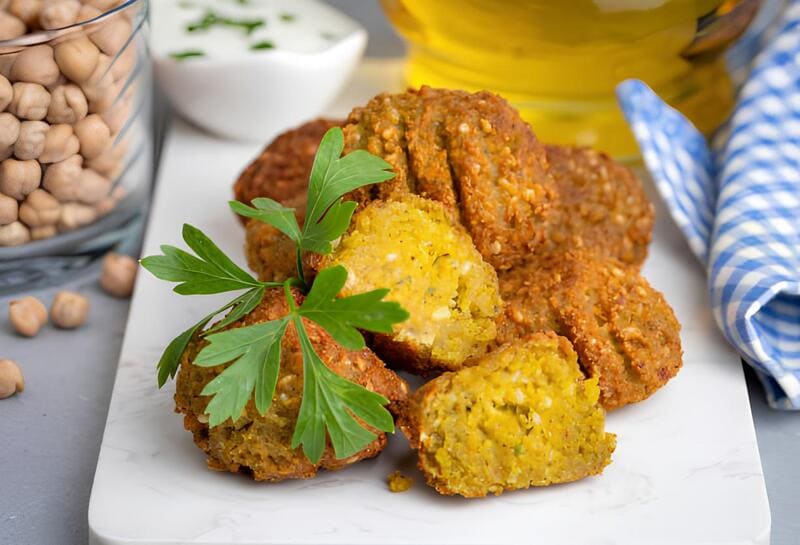
Falafel, also known as Tamiya in Egypt, is a beloved dish with origins tracing back to the heart of the Middle Eastern and North African culinary traditions. This vegan delight made from chickpeas or Fava Beans offers a superbly satisfying blend of herbs and spices, making it both delicious and aromatic.
The charm of falafel lies in its crisp exterior and tender interior. Frequently enjoyed in pita bread with tahini sauce, fresh vegetables, and pickles, falafel’s crunchy texture and flavorful bite make it an irresistible favorite. Simple yet authentically Egyptian, this recipe ensures you can enjoy traditional falafel at home.
Ingredients
- 1 kg chickpeas, soaked overnight
- 1 onion, chopped
- 4-5 garlic cloves
- 3 stalks of parsley
- Large pinch of salt
- ½ teaspoon coriander powder
- ½ teaspoon cumin powder
- ¼ teaspoon white pepper
- 1 teaspoon baking soda
- Vegetable oil for frying
Preparation
- Drain the soaked chickpeas and rinse thoroughly.
- In a food processor, combine chickpeas, chopped onion, garlic, and parsley. Process until the mixture becomes smooth and finely textured.
- Transfer the mixture to a bowl and mix in salt, coriander powder, cumin powder, white pepper, and baking soda until well combined.
- Allow the mixture to rest for about 30 minutes.
- Form the mixture into small patties or balls, ensuring they hold together.
- Heat vegetable oil in a pan over medium-high heat.
- Fry the falafel in batches, ensuring not to crowd the pan. Each batch should take about 3-4 minutes, turning until golden brown on all sides.
- Remove the falafel with a slotted spoon and drain on paper towels.
- Serve hot, ideally with pita bread, tahini sauce, and an assortment of fresh vegetables and pickles.
Did you know?
Falafel, or Tamiya, holds a special place in Egyptian cuisine and is often enjoyed as a staple street food. While chickpeas are commonly used globally, Egyptian falafel is traditionally made from fava beans—another ancient ingredient deeply rooted in the region’s agrarian history. This distinction contributes to a unique flavor and texture that sets Egyptian falafel apart from other Middle Eastern variations.
Historically, some speculate that falafel may have originated in ancient Egypt, perhaps as a protein-rich meal replacement during periods of religious fasting. Over time, falafel spread through the Middle East, becoming a beloved dish in many countries, each adding its own twist.
Falafel is not just a testament to the rich, shared culinary heritage of the Middle East and North Africa but also a versatile dish that caters to modern dietary preferences. It’s naturally vegan and vegetarian, making it an excellent choice for those seeking healthy and environmentally friendly meal options. Whether enjoyed in a sandwich, atop salads, or simply as a crispy snack, falafel continues to delight and nourish people around the world.
